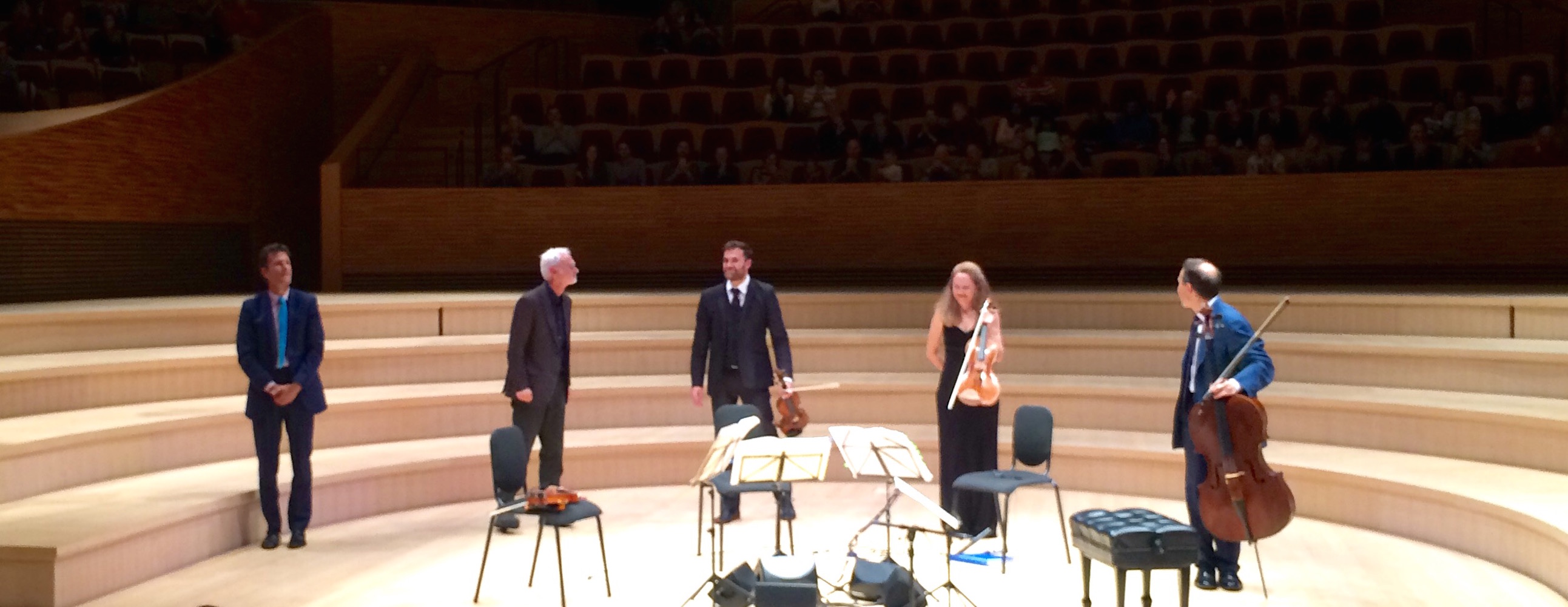As a fan of composer John Adams and of chamber ensembles, I can only describe the St. Lawrence String Quartet’s performance at Bing Concert Hall on Sunday as simply and utterly amazing.
In celebration of John Adams’s upcoming 70th birthday in February, the quartet, featuring Geoff Nuttall and Owen Dalby on violin, Lesley Robertson on viola and Christopher Costanza on cello, performed movements from Adams’s “John’s Book of Alleged Dances” as an early birthday present of sorts for Adams, who was in the audience. They also performed two other iconic string ensemble pieces: Joseph Haydn’s “String Quartet in E-flat Major” and Ludwig van Beethoven’s “String Quartet in A Minor.”
Even as someone who is not a huge fan of early classical music, I was wonderfully delighted by the quartet’s rendition of Haydn’s “String Quartet in E-flat Major.” Opening with an energetic allegro, the quartet wastes no time in capturing the full attention of its audience. Bouncing, swaying and almost dancing along with the music, the St. Lawrence String Quartet is almost as entertaining to simply watch as it is to listen to. Throughout the Haydn piece, the quartet exuded a constant stream of energy, even (or perhaps especially) when the music itself was calm. This energy skillfully turned a piece that could have perhaps been somewhat boring into a lively and dynamic opener.
In an extreme switch in style, the quartet performed Adams’s “John’s Book of Alleged Dances” as its second piece. Composed as an experimental series of dances with no dance steps (hence the name “Alleged Dances”), this avant-garde composition by John Adams features a recording of a prepared piano. A rather unique-sounding instrument created by the composer John Cage, a prepared piano is essentially a piano that has had various objects such as nuts, bolts and nails placed within it to create percussive sounds and rhythms. Repetitive, catchy and even anxious at times, the prepared piano rhythms created a somewhat steady beat beneath the quartet’s melodies and harmonies.
Performing a piece in front of its composer is no doubt a daunting endeavor, but the St. Lawrence String Quartet pulled it off magnificently. The quartet has worked with John Adams for years, and it showed in their wonderful interpretation of the “Alleged Dances.” Opening with the frantic and lively “Toot Nipple,” the quartet gracefully set the atmosphere for this experimental piece. From the wild hoedown-esque “Dogjam” to the somewhat calmer pavane dance of “She’s So Fine,” each dance had its own style, theme and certain breath of life to it. The quartet was not only able to identify the essence of each dance but was also able to clearly and masterfully express that essence to the audience — an extremely impressive task that can be the difference between hearing music and truly experiencing music for the audience. There was not a single uninteresting moment throughout all eight of the movements: Every single second had an unmissable and undeniable energy that filled the entire theater and the bodies of each audience member.
For the finale, the quartet performed its rendition of Beethoven’s “String Quartet in A Minor.” Completed in 1825, this composition was one of Beethoven’s final works and was originally composed with four movements. However, after falling seriously ill and recovering, Beethoven composed a central fifth movement, an andante headed with “Sacred Song of Thanksgiving to a Deity from a Convalescent, in the Lydian Mode.” This third and central movement in the composition stands out from the original four in its expression of darkness, emotions and ambiguity — perhaps an indicator of Beethoven’s transition from classical style into the more emotional romantic style.
Opening with the allegro, the quartet energetically swayed as it performed this untraditional sonata; however, it may have been too energetic, as the first violinist’s string snapped a few minutes into the performance. While this paused the performance for a minute or so, it is a clear indicator of what makes the St. Lawrence String Quartet so special — the raw and palpable energy that it puts into every measure of every piece. After the restringing of the violin, the quartet flawlessly resumed its performance without a single hiccup. Reaching the third and central movement, the quartet passionately expressed the sensations of sorrow, of despair and of eventual hope. It concluded with the two final movements, both of which were hopeful and lively.
What makes a chamber ensemble excellent? Is it achieving technical perfection, or being able to express emotions to an audience, or interpreting a piece in new and exciting ways or perhaps something else entirely? To be completely honest, I have no idea. However, whatever the answer may be, I can say with complete confidence that the St. Lawrence String Quartet possesses it, and I look forward to seeing them again.
Contact Benjamin Maldonado at bmaldonado ‘at’ stanford.edu.
